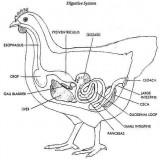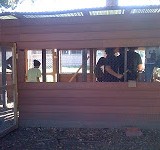Mrs. Homegrown here:
So–here’s the story of another mistake we made. When Erik and I first got chickens we didn’t lay out a plan for dealing with the chickens as they aged. That was the mistake. Simple as that. Make your plans, people!
We learned how to slaughter chickens–we knew we could do it if we needed to–but we never really sat down and decided what would happen to our ladies when they stopped laying. We’re very good at procrastinating that way.
What happened is sort of surprising, looking back.
I’ve not eaten chicken since high school (or other meat, except rarely, fish). My objections have never centered around the morality of killing animals for food, but rather a long-standing objection to how the animals were treated within the industrial farming system. I wanted the chickens so I could have constant access to guilt-free eggs.
Erik was a meat eater up until we got the hens. Then he fell in love with their funny ways, fell out of denial, and realized where his tasty chicken dinners really came from. He went veggie–more or less.
Somehow we did a polar flip. While keeping chickens made him a vegetarian, it made me less sentimental. It’s not that I dislike them. I love having them around. All I can say is that somehow my relationship to them was clarified through experience. I’d sit out by the coop and think, “Yep, I wouldn’t mind eating one of those–and sure as heck they wouldn’t mind eating me, either.”
Meanwhile, Erik went all Buddha on me. He developed relationships with our four hens and would not consider culling them.
That meant we had a chicken retirement home on our hands–and a distinct lack of eggs coming in–and no hope on the horizon, unless it came in the form of a convenient hawk.
But now that the bell has tolled for two of our hens (and no, I am not jigging when Erik is not looking) we’re making decisions on how to handle future flocks.
An aside:
There’s no right or wrong in this cull-no cull debate, though folks can disagree vehemently on the topic. I’ve always said that if you’re a meat eater, raising your own meat is the finest thing you can do. If you want to keep hens as pets, that’s also totally legit.
I have to say that in the city, where we have limited space and laws against roosters and backyard slaughter, our hen keeping operations are always, by necessity, somewhat unnatural. For the most part, backyard flocks are disconnected from the natural cycle of mating and birth, and so also seem to end up disconnected from the cycle of death. It’s no wonder lots of us end up thinking of our hens as pets. Heck, a lot of us buy them at pet stores!
The two paths:
For Erik and I there were two paths. Either we’d decide to embrace carnivorism and resolve to treat our layers in a more business-like fashion, meaning we would not name them and we would promise to make soup out of them when the time came. Or we’d decide–consciously— to support our old layers in their retirement. To do this, we’d need to develop a system that would allow us to bring in new layers, but still have room for old layers. A plan sort of like this one:
The Staggered Chicken Plan:
Note: Our current flock has taught us that four hens laying at their peak gave the two of us far more eggs that we could eat the first year, and plenty of eggs the second year and into the third. That’s how we came up with these numbers. If you need more eggs, you’d need more hens.
We start with three fresh pullets. At age three, when they slow their laying, we’d introduce three more fresh pullets. We would then have six hens and plenty of eggs, even if we have some die-off from the oldsters in their 4th or 5th year. When the second batch turned three, we’d get three more young ones. The first trio would then be able to spend their sixth through ninth years playing canasta or watching the telenovelas or whatever, and we’d still have plenty of eggs coming in from the younger birds. This plan is based on an assumption that most hens won’t live past nine though some do, of course. Hopefully the numbers will even out.
The decision:
What it came down to for us was whether we’d be willing to invest the time and money into starting a retirement community. Not only would we have to build a new coop to hold nine hens–as per the Staggered Chicken Plan–but also we’d have to commit to feeding all those useless birds.
Alternatively, we could keep the set up we have right now (which holds 4, maybe 5 birds at the most) and resolve to cull the hens. New hens every three years.
I personally was fine either way. I could see the advantages of each approach. But Erik (the big softy!) decided he didn’t feel right about culling the hens. Putting his money where his mouth was, he agreed to redesign and rebuild the coop to keep his ladies off the chopping block.
So I guess we’re changing our name to Sentimental Farms! Time to design that new coop…






We use the staggered chicken plan and used to cull our own chickens. A few years ago a friend pointed me to two brothers who live in a neighboring town that do butchering for a small fee. Since then, we have used their services… we drop the birds off live and pick them up cleaned, plucked, and in bags. All of this for the low price of $2/bird. I know they do chickens on Saturdays, and I have been told they do rabbits on Wednesdays. I find butchering chickens to be too much work for just the handful of chickens we do at a time.
ok. I am all for the raising of your own meat, and I would be the same as Eric here I think. I would set up and raise the animal and then fall in love with it and not be able to eat it when it was time. I think that is why I will never be able to raise rabbits for meat. I don’t know about chickens, because I have never tried to raise any sort of bird and have a little different feel about them than I do mammals. I know that would probably totally change once I got used to them, and then I would be in the same boat and unable to eat them. Kudos for both approaches and your flexibility about it!
That’s great news! I can’t wait to see the pictures of the new coop and the lucky hens 🙂
I think you have a very well thought out article on the topic, but I want to add that there are other considerations besides just egg laying!
1. Chickens make fast nutrient rich compost for the garden. Kitchen scraps go in one end, good fertilizer comes out the other. This happens regardless of age.
2. An old hen will still scratch around to till the soil and catch bugs like horn worms.
3. An older hen can teach a younger pullet the ropes. They are social animals and they definitely learn from each other.
4. Also, even if they are not laying, if they are a good broody they can hatch and raise fertile eggs.
Lastly, consider re-homing your healthy older hen before culling. The Austin meetup has people who love chickens as pets and will take older hens even if they don’t lay much anymore.
You guys are awesome. There is no question about THAT!
Wow, great post. Although my decision was very different from yours (no names, slaughter at loss of productivity, chicken stock, comfortable with ethical carnivorism) I’m really glad that you’re addressing this issue, even if it comes a little belatedly for yourselves. Prospective backyard chicken folk should be aware that eventually they’ll have to make such choices.
I agree that the choices you outlined are pretty much what it comes down to. Not to argue the point at all, but one consideration in my decision making is the feeding of grain to livestock, when there are hungry people in the world who could eat the grain. I have enough of a guilt issue over that as it is, and I do try to displace some of the grain with acorns and other feeds. I hate the reality that my chickens compete for food with hungry children – and win. The idea of feeding any animal past its productive lifespan was ruled out for me on that criterion.
Just saying– you CAN name the animals and still eat them. We (my family) always did when we raised food-animals (pigs to cows to chickens). But aside from that, good luck with your elderly-chicken keeping 🙂
Alas, the problem with introducing new hens to an already established flock is pecking order. The pullets will always be at the bottom, which can create potentially lethal conflicts. Unless you have completely different facilities for both flocks, you might be letting yourself in for some serious conflict.
Cull hens that don’t lay. Cull your roosters if you’re in an urban area. Letting sentiment rule is a particularly bad idea given the cost of chicken feed these days.
I have been going through similar thoughts, but we are only allowed 6 hens. I have 3 now, coming up on 1 year old. Figured when the egg production slows down that I’m buying eggs again, I’ll consider adding more.
I agree entirely. I raise rabbits for meat, and also just yesterday sent 35 old hens to freezer camp, from which will come great quantities of soup or chicken ‘n dumplings. I choose to eat meat, but I choose not to participate in industrial ag. This is my compromise – I will care for the animals myself, look into their faces, and always treat them with dignity. One of my good friends is a vegetarian, for philosophical reasons… and she agrees with you – if one is going to eat meat, one should really own the process.
When I was four, I had two pets–rooster and bunny. Someone gave me the chick and bunny. We had no other pets. Or chickens. I went out one morning to feed the bunny, and the rooster attacked me and I ran as he chased and attacked me over and over. Mama grabbed me up and Daddy kept kicking the rooster as he kept attacking me, spurring me. I was cut from shoulders to ankles. Later that Sunday, Mama told me the rooster would keep attacking me, and would it bother me to eat him. REVENGE was never so sweet. I remember sitting there, eating the pulley bone, happy.
I could eat everyone but Fancy. Well, I would eat her before I let her go where I could not take care of her. I won’t kill her just because she does not lay. However, I will run a retirment home if I need to.
Several months later, someone gave me a kitten. Mama said she heard my little voice from the back seat. “Mama, will we eat my kitten.” She was just horrified.
drop the buddha and get with the lao tzu!
I’m chicken obsessed. I currently have 19 layers but have another 10 meat chickens on their way. Currently we’re getting 7-8 eggs a day. Occasionally we’ll get a lucky baker’s dozen. What do we do with that many eggs? Beats the hell out of me. We give a lot away, but not THAT many. And most mornings we have eggs for breakfast, but that’s only 4 eggs. That’s when you know you have a problem. You can’t keep up with egg production but want MORE CHICKENS! LOL
awe – I am afraid we made the same mistake – 7 chickens will all age out at the same time…. I do have room for more though, so can slip in some eggs the next time one goes broody but will definitely have to instigate the canasta corner for the old biddies…maybe with some simple arts and crafts?
Aw. I like the image of your chickens living out their natural lives in the sunshine.
Roxanne
Although a chicken can live to an old age of 8 to 13, it is very rare. If you don’t lose your hens to predators, you will to disease and simply being worn out. In my experience many hens die by the age of 3, and if they survive that milestone, they’ll die by 6. I do have a couple of girls who are still ticking at 7, but the rest of their flock is long gone. Elderly hens do require special care – I’ve had to trim Eleanor’s toe nails because she can no longer scratch and keep them down. You can read about that on my blog (surprising what people want to read about!)
Terry at http://www.HenCam.com
@Terry: Thanks!
Everyone: If you got a chicken jones you should go hang out at Terry’s place: http://www.hencam.com Yep, that’s a hen cam for your hen viewing pleasure.
We always raised chickens and rabbits for food growing up. Eventually I want to do so again, but we don’t really live in a big enough place to do so, especially with our dogs. For us, only a few chickens got named. As for the rabbits, the parents were pets and the babies were not, unless they were to become a parent. It worked for us.
I have to say that I do like the idea of sending them out to be butchered. I don’t mind the chopping up part, but I don’t know that I’m strong enough or agile enough to quickly kill a chicken or a rabbit, and my husband would probably procrastinate long enough that the meat would be too tough — just because he doesn’t want to deal with the hassle of livestock. If it’s an elk, he can take entire months. *sigh* Still, it seems odd to me to hire somebody else to do what I could conceivably do for free.
I hope that your new generations get along well together. We have two generations and we ended up selling one troublesome hen who was causing problems in the pecking order. She was 2 years old and still laying eggs, so I have reassured myself that the new owners will keep her around for a long time.
Coop question: we’re in the middle of converting an 8X10 tuff shed into a chicken coop. We’ll be doing the deep bedding method in the run but what should we put on the plywood floor of the shed, other than perhaps linseed oil? Deep wood shavings? A scant amount of straw? I assume we sweep it out and put in fresh something-or-other once a week; is that enough to keep the matter in there from rotting the floor? Or ought we to milk-paint or seal it somehow?
Joss, chickens do at least half their shitting overnight. So if any place should have deep bedding it should be where they sleep, which is presumably the coop. I wrote a post a while back on the temporary winter quarters we constructed for our layers inside our shed, which has a wood floor:
http://livingthefrugallife.blogspot.com/2009/12/winter-quarters-for-girls.html
You might find it useful.
Joss,
Kate is correct. I use wood shavings under the roost and straw in the run. I clean out the roost area about once a week and throw the poop/shavings on the compost pile. The run, which has a deep layer of straw, does not get cleaned often–just once a year.
I agree with Terry (and I highly recommend her blog)—the average flock of hens tends to cull itself. Well, at least mine does. Whether it is an untreatable illness or injury or the occasional predator—they just seem to know when their time is up, and I replace them when three or four have died. Since I lose most hens to old age (about 4 or 5 years, on average) or illness, I’m not inclined to eat them at that point anyway! As for my unproductive hens competing for grain with starving children…well, I guess instead of making a snarky comment, I will just say that one can “buy” a flock of chickens (or bees or sheep or many other animals) through the Heifer Project, and provide ongoing sustenance, education, and a small living for a whole village of people.
So just to be sure I understand: deep bedding in the coop which gets cleaned out and replaced once a week. Or, per Kate’s blog, deep bedding in the coop inoculated with soil with a tarp underneath to protect the floor that only gets cleaned out … once a year, like the run? With an 8’X6′ coop, the latter may be the more affordable route. We haven’t constructed the interior of the coop yet or cut out the chickens’ door between the run and the coop; I suppose these doors should be almost a foot off the shed floor, to keep bedding from spilling out every time one is open? Thank you so much.
@ Joss: Pizza boxes! I line the unfinished plywood with old pizza boxes or other cardboard, then add shavings or shredded paper over that. Just pull out the box once a week or so, and replace.
Disclaimer: my pullets are only 10 weeks old. I do see value in elder hens, but I draw the line at building an elevator to the roost!
Hey Joss,
What I do is a shallow bedding of wood shavings under the hen’s roost that I clean out once a week or so. The rest of the coop and the adjacent run has deep bedding that I rarely clean. Does that make sense? Perhaps we can post a video tour at some point soon.
Joss, while it’s true my deep bedding arrangement was only cleaned out once per year, the chickens were only on that deep bedding for ~4 months. So it wasn’t a year’s worth of manure in there. The rest of the year we rotate them daily around our yard and during that time their coop requires regular cleaning.
Mr & Mrs Homegrown, the legions of your adoring fans would love to see a video tour of your coop and how you manage your flock!
Eric, I’m with you. I tried to retain that farmer-mentality. It lasted about an hour. Once my daughter named the chicks, it was all over. My old biddies can have free room and board till their last cluck.
That makes sense (and is a relief). A video tour would be wonderful.
Ah, a familiar problem indeed. I’m not sentimental about our hens, but with two tween age kids, there is NO culling. Fortunately, I built a coop that was larger than my flock and have the ability to add chickens over time. I started with five hens, lost two after a few years, and just added 5 more a few weeks ago. I keep all the hens together. One thing I would add to this well written post, is that adding new chickens to an existing flock represents a real logistical challenge – new chickens need a quarantine period to prevent the spread of disease that could wipe out the whole flock and then there’s dealing with the disruption of the existing pecking order. The Murray McMurray hatchery blog has a good series of articles on the subject for those interested in learning more.
@PlanterTomato and others: Yes, I was amiss in not talking about the integration problem. It’s a pain–but possible. Still, I’m so not looking forward to it! (Another check in the cull box, as far as I’m concerned.)
A few more coop questions:
1. Our 5 buff Orpingtons will be 3 months old in a few days so we figure we should start pondering nesting boxes. We intend to have 2 boxes for the 5 to share. Space wise, it’d be very convenient if we could stack them so that one was a few inches of the floor while the other was maybe 18 inches off the floor, with a ramp for them to walk up and down. Is that ok? Or is that just asking for a bunch of broken eggs?
2. We bought a big thing of linseed oil to apply to the interior. My husband was concerned about the combustible warning. I remember hearing about that in the book with regard to rags, but I can safely reassure him it’s not going to make the coop just burst into flames, right?
Thank you for allowing me to pester you. We’re enjoying our first chickens and first raised bed immensely; the bicycle has happily replaced the 2nd car; and I won’t even list the soaps and balms and such. Suffice it to say, we owe you guys 🙂
Hey Joss:
Congrats on the chickens! We’ve never done a double-decker nesting box but we don’t see why that wouldn’t work fine. They might all try to share one of the boxes–don’t be surprised if they do. But they generally put their eggs where they belong, so you shouldn’t have broken eggs.
Linseed oil. Well, it’s true, you always want to be careful with any oily rags/finishing rags of any type. They truly can burst into flame. A sealed container is good. Or hang them up to dry on a line, far from anything that can catch fire. But the coop should not burst into flame. Just give it lots of time to dry out before you put the combustibles–straw and chickens–inside.
Have you read our post on deep bedding? This is one of those basic things, helpful things that I want to share with all new chicken owners:
https://rootsimple.wpengine.com/2011/04/deep-bedding-for-chickens.html
We’re so glad to hear that you’re enjoying your chicks, bikes and salves. It’s addictive, isn’t it?
You’re right about culling and eating non productive chickens!
I agree totally!
This is why I buy, raise, then kill and eat at my own whim and will dogs and cats. They don’t lay eggs or do anything at all productive–at least nothing my chickens don’t already do, like provide protector services. They are far meatier than the tiny little chicken bodies. Easier to kill too. But I have a friend who does it for free, so it’s really economical!
There is no simple answer here, to each her/his own, and my view is, let’s just eat dogs and cats when they no longer do the limited thing we bought them to do in our fantasies of who they are and what they are “for.”